
High-post bedstead, New England, ca. 1800. Birch and pine with red wash. H. 72", W. 46 1/2", L. 70". (Courtesy, Austin T. Miller.)
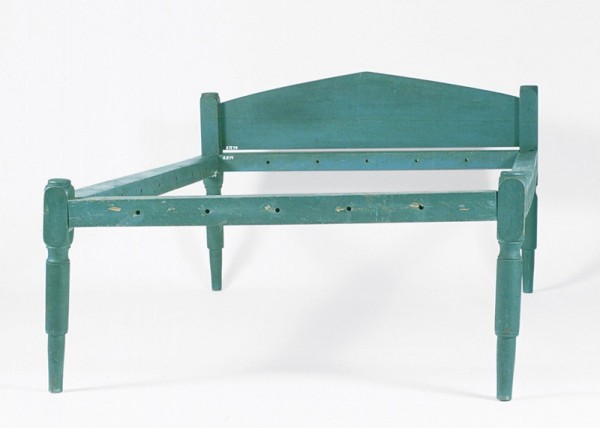
Low-post bedstead, area of Barre, Massachusetts, 1800–1820. Woods not recorded; blue-green paint. H. 31 1/2", W. 51 3/4", L. 74 3/4". (Courtesy, Old Sturbridge Village, gift of the Derby family, 5.17.79.) The bedstead descended in the Bixby family of Barre.

Field bedstead, New England, ca. 1800. Birch and pine with red wash. H. 64" (without canopy), W. 54 1/2", L. 70". (Courtesy, Austin T. Miller.)
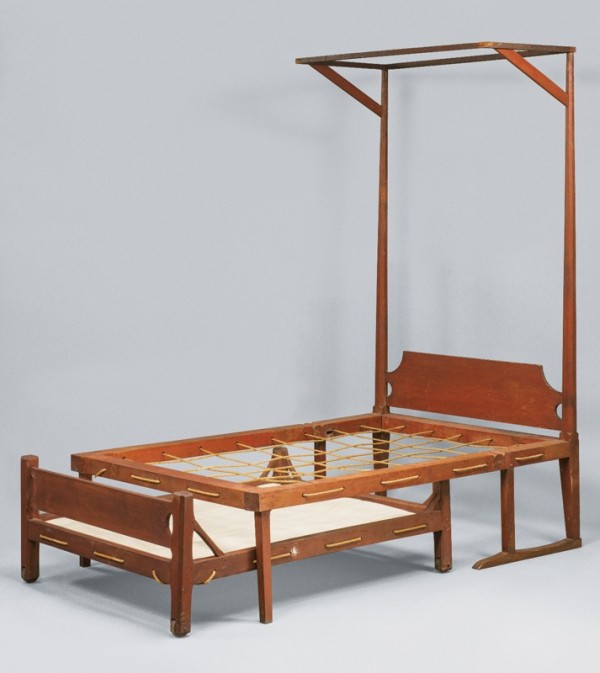
Turn-up, or folding, bedstead, Connecticut Valley in Massachusetts, 1740–1800. Birch and pine with red wash. H. 90 1/2", W. 50", L. 75 1/4". (Courtesy, Historic Deerfield, gift of Henry N. Flynt, 0845; photo, Penny Leveritt.) The bedstead is unusual in having trestle feet at the head; the tester has been reconstructed using new parts and refashioned old parts.
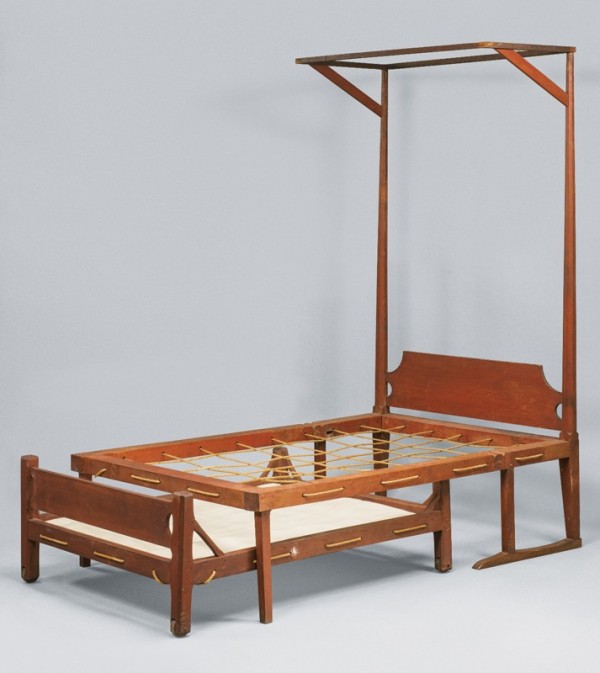
Trundle bedstead, New England, 1740–1800. Maple with red wash. H. 28", W. 36", L. 38". (Courtesy, Historic Deerfield, gift of Charles F. Montgomery, 0997; photo, Penny Leveritt.)
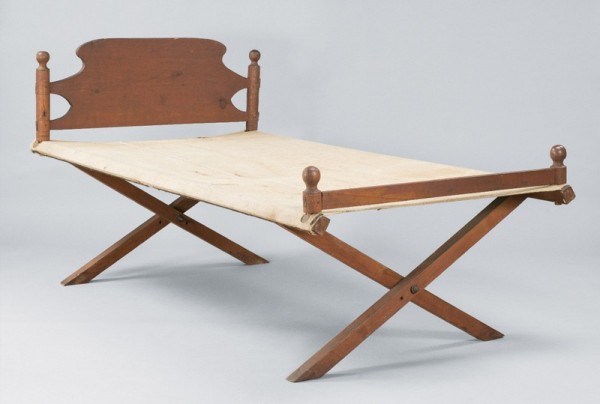
Folding cot bedstead, New England, 1800–1835. Maple, beech, and pine with red wash, and linen canvas. H. 35 1/2", W. 38", L. 76". (Courtesy, Historic Deerfield, gift of Mr. and Mrs. Henry N. Flynt, 53.094.2; photo, Penny Leveritt.) The headboard and footboard lift off, permitting the X-frame to fold.
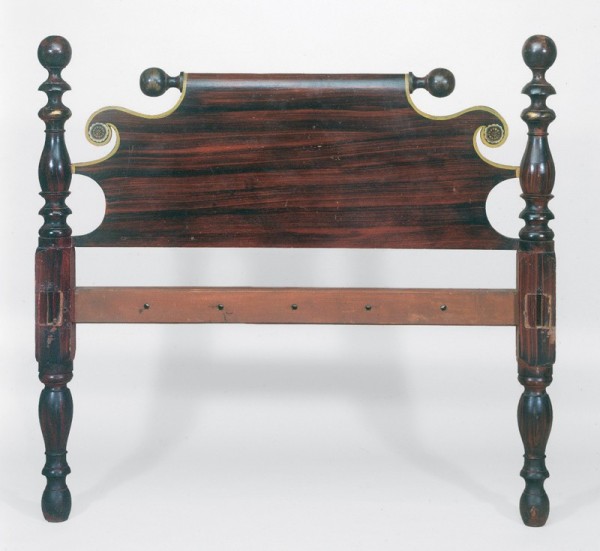
Headboard of a French bedstead, area of West Leeds, Maine, ca. 1830–1840. White pine and maple grain–painted in black on red to simulate rosewood, accompanied by painted yellow banding and stenciled bronze decoration. H. 51 1/2", W. 53 1/4". (Courtesy, Maine State Museum, gift of Maine State Organization, D.A.R., 77.13.1.) The bedstead originally belonged to Stephen R. Deane (1816–1898), West Leeds, Maine, and was acquired from the family home.
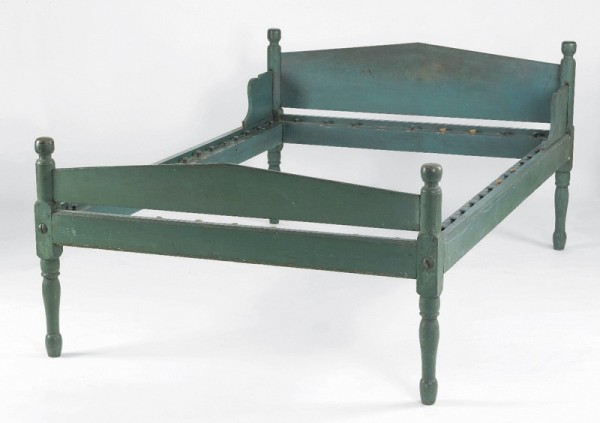
Low-post bedstead with pillow panels, eastern Pennsylvania, 1790–1820. Yellow poplar with blue paint. H. 33 1/2", W. 51 1/2", L. 76 1/2". (Courtesy, Pook and Pook, Inc.) The bedstead formerly was in the collection of Dr. and Mrs. Donald A. Shelley.

Detail of the rear surface of the headboard of a field bedstead possibly by Brewster Dayton (d. 1796), lower Housatonic River valley at Stratford, Connecticut, 1780–1795. Yellow poplar and maple with red stain. (Bedstead) H. 85", W. 49 1/2", L. 73". (Courtesy, Winterthur Museum, 1952.0097.) The headboard is raised to expose the rabbeted top surface of the rails mounted with pins, or buttons, to accommodate cord or a sacking bottom. This object has a history of ownership in the Blakeman family of Stratford.
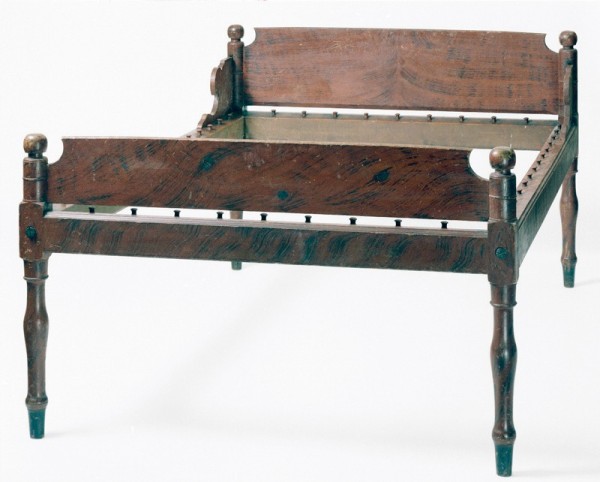
Low-post bedstead with pillow panels, eastern Pennsylvania, probably Montgomery County, 1800–1830. Maple and pine grain–painted in browns to simulate mahogany. H. 35", W. 49 3/4", L. 74". (Courtesy, Winterthur Museum, 1981.0010.) This bedstead has a history of ownership in Pottstown.
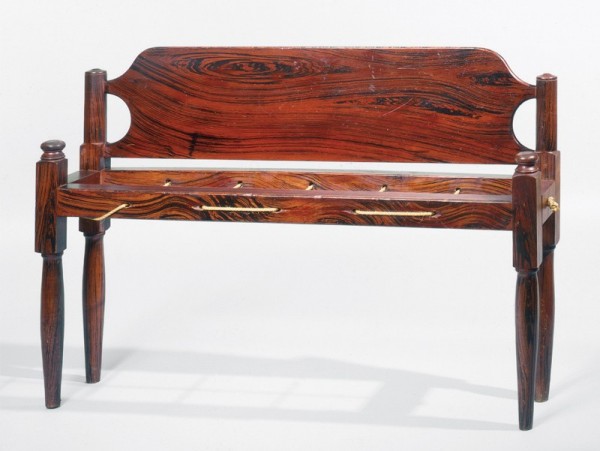
Low-post bedstead, probably New Hampshire, 1820–1830. Maple and pine grain–painted in red and black to simulate rosewood. H. 36", W. 53", L. 76". (Courtesy, Old Sturbridge Village, 5.17.38.)
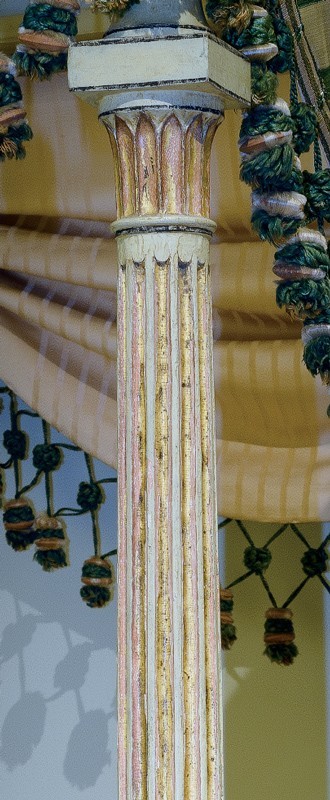
Detail of a post of a high-post bedstead, Albany or New York, ca. 1800. Maple post with white paint and highlights in gold leaf. (Bedstead) H. 96 3/4", W. 57 1/4", L. 77 1/2". (Courtesy, Winterthur Museum, 1955.0786.) This bedstead reputedly belonged to Gov. Joseph C. Yates (1768–1837) and his third wife (m. 1800), Ann Elizabeth Delancey.

Detail of a post of a high-post bedstead, New England, 1800–1815. Cherry and birch with painted white ground and decoration of red blossoms and shaded leaves of green and gold with dark blue grapes and tan acorns, all accented by borders and striping in gray, black, and gilt. (Bedstead) H. 81 1/2", W. 54", L. 73 3/4". (Courtesy, Historic Deerfield, gift of Mr. and Mrs. Henry N. Flynt, 59.011; photo, Penny Leveritt.)
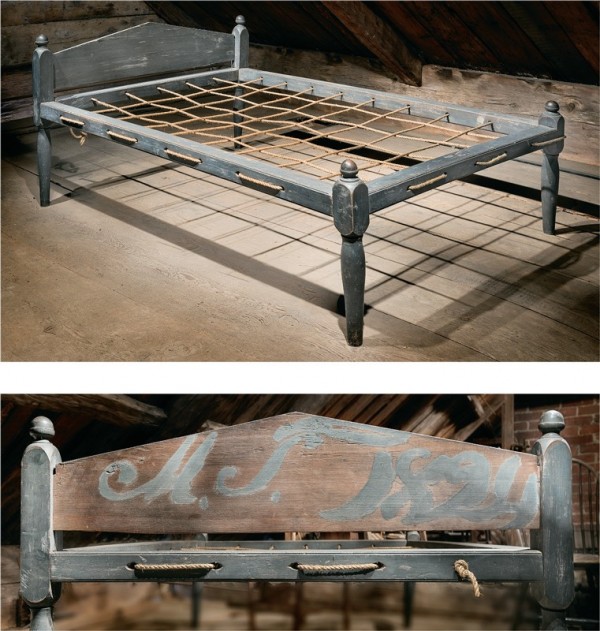
Low-post bedstead, coastal New Hampshire, ca. 1824. Maple and white pine with gray paint. H. 36 3/4", W. 53 3/4", L. 78". (Courtesy Woodman Institute, Dover, New Hampshire, gift of Mrs. Ellen Rounds, T1057; photo, Rob Karosis.) Mrs. Rounds inherited the bedstead from the Drew family of Dover in the 1880s. Inscribed on the rear surface of the headboard in gray paint with initials and date “M.T. 1824.”
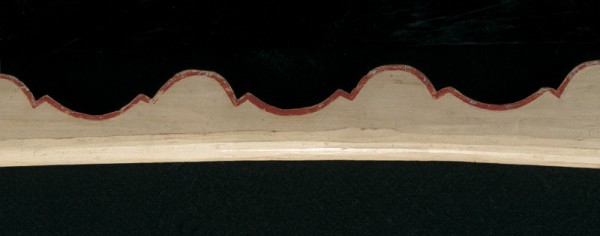
Detail of a scalloped bedstead cornice, New England, 1770–1800. White pine with painted white ground and painted red edging (border). (Courtesy, Colonial Williamsburg Foundation, Museum purchase, 1970-147,11.)
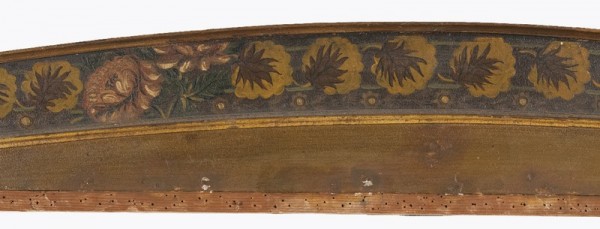
Detail of serpentine-shaped bedstead cornice attributed with its bedstead to Langley Boardman (1774–1833), Portsmouth, New Hampshire, 1800–1810. White pine cornice with painted black ground and painted red flowers accented by gold foliage and moldings. (Courtesy, Historic New England, Museum purchase, 1969.573.) The cornice and its bedstead are presumed to have belonged originally to William Hale (1765–1848) and Lydia Rollins Hale of Dover, New Hampshire, in whose family they descended.

Detail of a window cornice, probably Baltimore, Maryland, 1835–1850. Wood with painted black ground and gilded Greek key design. H. 7", W. 87 1/2", D. 7 1/2". (Courtesy, Maryland Historical Society, 1953.248.39.)

Detail of a window cornice (one of two), United States, 1825–1830. Wood and gesso with gilded ground and ornament, including Nelson balls, beading, and egg-and-dart molding. H. 7 1/4", W. 64 3/4", D. 9". (Courtesy, Munson-Williams-Proctor Art Institute, Museum purchase, 57.65.1–2.)

Window cornice (or valance), New England, 1830–1840. Pine with green paint and stenciled decoration. H. 7", W. 38 1/4". (Courtesy, The Henry Ford, 57.99.2.)
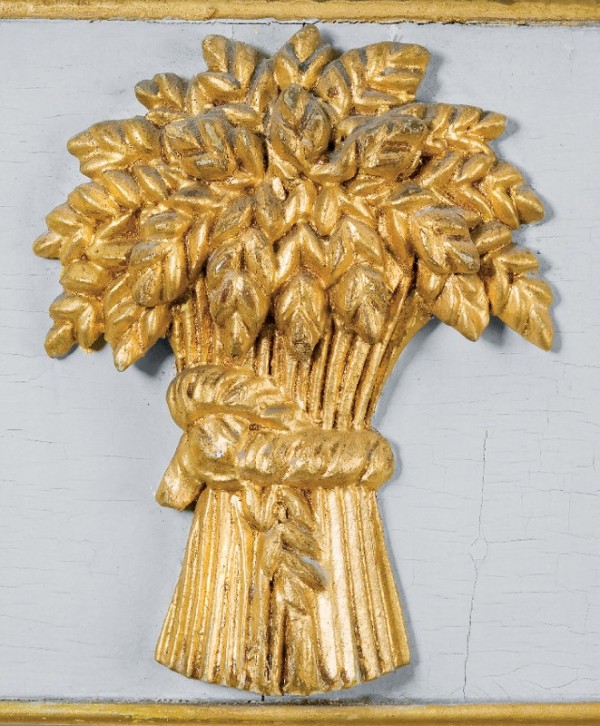
Detail of the cornice of a bedstead made by Jacob Sanderson (1758–1810), Salem, Massachusetts, 1807. Pine cornice with white, or off-white, paint and gilded sheaf of wheat ornament carved by Samuel McIntire. (Bedstead) H. 84", W. 58", L. 78". (Courtesy, Peabody Essex Museum, gift of Miss Miriam Shaw and Francis Shaw, Jr., 122349.) The cornice and bedstead were made for merchant Aaron Waite, as per dated billhead.
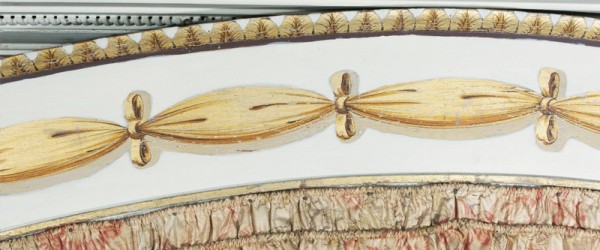
Detail of an arched window cornice (set of three), probably New Hampshire, ca. 1807. Pine with off-white painted ground and light yellow painted fabric puffs, bows, and leafy border, all detailed with gilded accents, the fabric puffs accented along the bottom in deep amber and shaded in pale yellow. H. 10 1/2", W. 54 1/2". (Courtesy, Historic New England, Rundlett-May House, Portsmouth, N.H., gift of Ralph May, 1971.2042.)
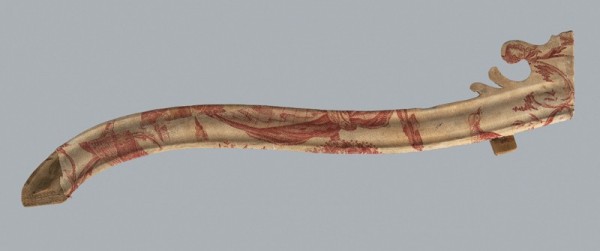
Fragment of a bedstead cornice, probably New York City or New York State, 1770–1800. White pine covered with English red-on-white copperplate-printed cotton of ca. 1770. (Courtesy, Colonial Williamsburg Foundation, Museum Purchase, 1964-223,3.) The fragment is part of a cornice originally from the Glen-Sanders House, Scotia, New York.
